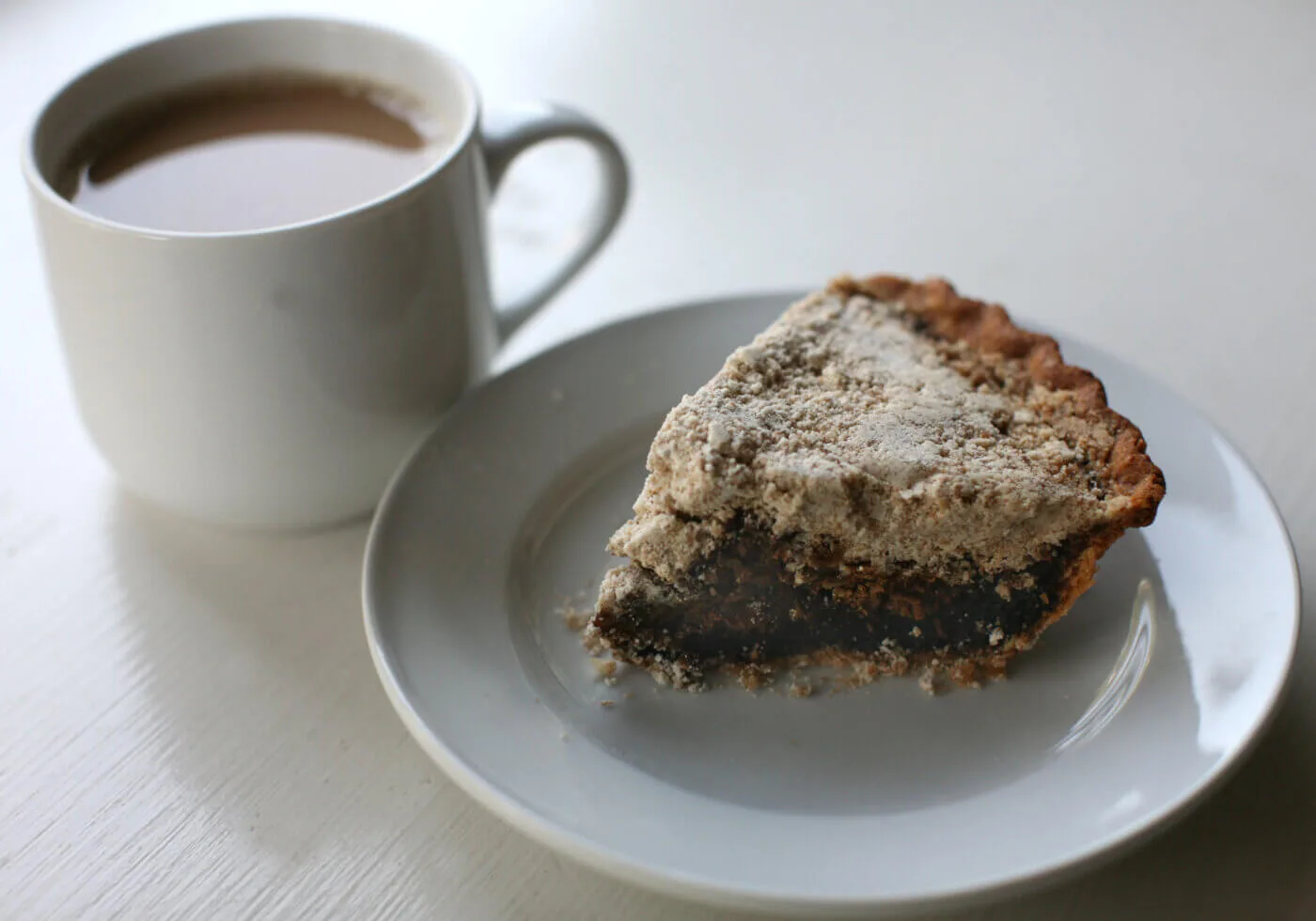
Shoofly pie. Photo courtesy of Jules.
Whether you head to Pennsylvania Dutch Country to get it or try a recipe or two for yourself, Pennsylvania Dutch food is the comfort food you didn’t know you needed.
Pennsylvania Dutch food is the cuisine of the Pennsylvanians who emigrated from parts of Germany and Switzerland—not Holland, as the name would imply. Pennsylvania Dutch food is a heavy, simple comfort food that relies on fresh, seasonal produce and other farm products. If you visit the Pennsylvania Dutch Country, seek out some of these foods—and be sure not to pass on any food that a church lady offers you. That’s probably the most authentic Pennsylvania Dutch food you can find.
READ MORE: 8 Pennsylvania-Made Foods (and Drinks) Just for the Adventurous
If a trip to the rolling hills of Pennsylvania Dutch Country is unlikely to happen soon, you can also try your hand at making some of these dishes on your own. After all, roughly 40 percent of Pennsylvanians today may be Pennsylvania Dutch based on their ancestry, even if they may not know it.
Chow Chow
Fun to say, even better to eat. Not to be confused with the dog, the chow chow of the Pennsylvania Dutch is a sweet-and-sour pickled vegetable relish. Cabbage, onions, peppers, green tomatoes, and other vegetables are finely chopped together and mixed with vinegar and pickling spices.
You’ll find chow chow at Amish groceries as well as roadside and indoor markets across Pennsylvania Dutch Country. But it’s also relatively simple to make yourself, especially if you have a bevy of late-summer produce, like green tomatoes, you need to use up. If you go so far as to can your chow chow to save for later, you’ll be employing the well-known frugality of the Pennsylvania Dutch.
Gumbis
Gumbis hails from Switzerland, brought to the U.S. by immigrants to Pennsylvania. It’s a layered dish of cabbage, meat, and fruit. While you might not find it on tourist menus, it’s a staple of true Pennsylvania Dutch cooking—a simple meal that makes good use of leftovers or scraps.
William Woys Weaver, preeminent food historian and author of “Pennsylvania Dutch Country Cooking,” says that sometimes families would eat one-pot meals like Gumbis communally and directly out of the pot without utensils. He told NPR that people would use bread for dipping and “sit around and pick at things out of the pot.”
Who doesn’t want to sit around and pick things out of the pot?
Pennsylvania Dutch Pot Pie
Yes, you can get pot pie in the frozen section at any major grocery store. But, you cannot easily get Pennsylvania Dutch pot pie just anywhere, because it’s nothing like the pot pie you’re used to. Actually, it’s not even a pie. Instead of a crust, the Pennsylvania Dutch add thick homemade noodles to their meat and vegetable stew. And as everyone knows, noodles make everything better.
Pickled Red Beet Eggs

Red beet eggs are hard-boiled eggs but prettier. These purplish eggs are pickled with beets and other spices. The red color, of course, comes from the deep color of beets.
This recipe is one that you can easily make yourself. Simply make and peel hard-boiled eggs, and then boil and peel beets (or just use canned beets). Slice your beets, and then add them to a jar with the eggs. Then, make your pickling liquid by simmering vinegar, sugar, salt, and spices of your choice (like cloves) together until the sugar dissolves. Let the vinegar mixture cool before pouring it over your eggs and beets; store the jar in the fridge for a couple of days before breaking it out to feast on your very own brightly colored pickled eggs.
Pennsylvania Dutch Pretzels

The storied state of Pennsylvania has yet another claim to fame: About 80 percent of all U.S. pretzels are made here in PA. But let’s zero in on specific pretzels—those of the Pennsylvania Dutch.
Back in the day, the Pennsylvania Dutch, as resourceful as they were, would just bake their pretzels at home. In 1861, Julius Sturgis opened the first commercial pretzel bakery in Lititz, a small town in the heart of Pennsylvania Dutch Country. The Julius Sturgis Pretzel Bakery still stands today and offers tours, lessons in pretzel twisting, and homemade soft-baked pretzels.
Sauerkraut

Sauerkraut may not seem particularly special, but Weaver, the Pennsylvania Dutch food historian, says that sauerkraut is the standard Pennsylvania Dutch food, no matter the background of a Dutchman. “It’s the one food that holds it all together,” he told the Pittsburgh Post-Gazette.
The Pennsylvania Dutch eat pork and sauerkraut on New Year’s Day for good luck.
Schales
Schales is a very old dish of eggs and vegetables like leeks and potatoes baked into a pie without a crust. It takes its name from that of the shallow pan used to bake it.
And here you were thinking that Pennsylvania Dutch food was all pig stomach.
Shoofly Pie
Shoofly pie is a molasses pie closely associated with and found all across the Pennsylvania Dutch Country and surrounding areas. But there’s more than one version of this famous pie: There’s gooey shoofly pie, which is called “wet-bottom” shoofly pie, and there’s also shoofly pie made with a dry bottom and a texture more like a coffee cake. This is excellent news: It means two pies to try instead of one!
READ MORE: You Know You’re a Pittsburgher if You’ve Eaten These Foods

For Rep. Susan Wild, supporting PA families includes reproductive rights and much more
Rep. Susan Wild wants to be very clear with Pennsylvanians: Donald Trump is committed to taking away women’s reproductive freedom, but he is not...

School districts working with anti-LGBTQ groups can cost your kids’ schools millions
Parents across South Central Pennsylvania are worried about the potential financial impacts working with anti-LGBTQ groups may have on their school...

VIDEO: Trump distances himself from his anti-abortion views
Donald Trump appeared on WGAL on Tuesday and continued to distance himself from his anti-abortion views claiming that reproductive rights are now a...

VIDEO: Community pushback gets school board to rescind decision on denying gay actor’s visit
Cumberland Valley School Board offered a public apology and voted to reinstate Maulik Pancholy as a guest speaker a week after the board voted to...

VIDEO: Project 2025 brings nuclear armageddon back into vogue
Project 2025 is a titanic document, with plans ranging from cutting half of all government employees to targeting reproductive rights on a scale...





